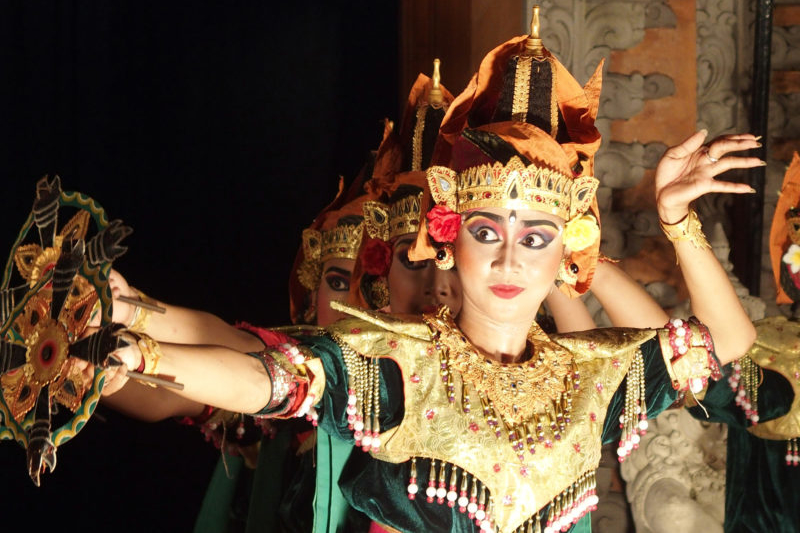After careful consideration of the various weather patterns affecting southeast Asia we came to the conclusion that Bali was the only sensible choice for our next destination. The rainy season was beginning for much of the mainland and we definitely wanted to make it to Indonesia at some point. Bali happened to be in it’s dry season and I’d heard many people talk fondly of Bali’s beaches. Other than that I didn’t know much about it. We were in for a real treat.
People have been flocking to Bali for several decades and that means that what used to be laid back little surf spots are now noisy sprawling overdeveloped cities. Kuta, the biggest tourist destination especially for surfers, was probably pretty cool 30 years ago but it sounds like a crowded tourist trap nightmare now. We skipped the cities in the south and headed inland for Ubud, which is also very popular with tourists but in a different way. Rather than being party central for Australian beach bums, Ubud has a reputation as the spiritual and cultural center of Bali.
Ubud has become so popular in recent years that it has some problems but those problems were overshadowed by the beauty and uniqueness of the culture, which is very alive and intact. While there is incredible natural beauty, people mostly go there to see the traditional lifestyles of the Balinese. Their religious beliefs and practices, which permeate all aspects of life, are truly charming and the fact that people come to see that and bring money with them means that the community benefits most by maintaining their traditions, which is the opposite of what happens in many places.
Indonesia is an incredibly large and diverse country but the vast majority of it is Muslim, except the tiny island of Bali, which has a unique hybrid of Hinduism and native animistic beliefs. Much of their livelihood and resources are devoted to the elaborate rituals and ceremonies that take place almost constantly. Their homes are ornate stone temples, with areas for ceremonies, sleeping and eating, and areas for their ancestors to rest. Here is a typical entrance to a home, but it could also be a business or guesthouse.
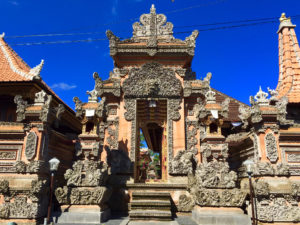
Every day, possibly several times a day, various types of offerings are made to their gods. These offerings are placed in front of their doors, in and around shrines, in the street, on motorbikes and cars, or anywhere that has some importance or a need for good fortune. The offerings are woven out of grasses and filled with flowers, rice, herbs, crackers, and other things and incense is usually lit as well. They are everywhere and it can be somewhat difficult not to step on them. It creates a feeling that people are constantly expressing their gratitude for the things they have in life. From what I could tell, they have a lot to be thankful for.
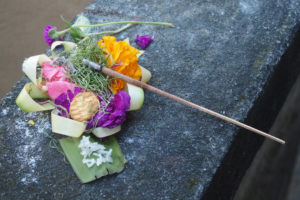
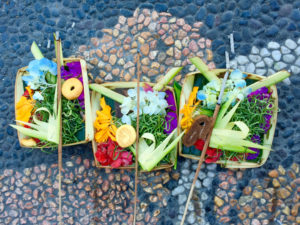
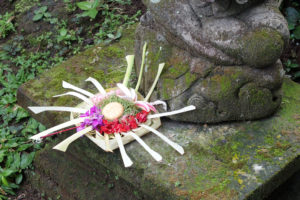
The Balinese are known for their distinctive music and dance traditions which generally form a part of the many ceremonies that take place. Ubud offers probably the best opportunity for an outsider to experience these without actually being invited to participate in a ceremony. It becomes a habit to ignore people on the street who are trying to sell things to tourists but when someone asked me if I wanted to buy tickets to that night’s gamelan performance, he had my attention.
The performance took place in a gorgeous outdoor temple-like venue. There were several segments of dances which were notable for the beautiful costumes and the unusual hand and eye movements which were choreographed into them. Each segment told a story, like a folk tale although there was no speaking. A gamelan orchestra performed the music, which was mind-blowing. Two sets of men, on either side of the stage, played their oddly tuned sets of gongs and there were other instruments too. It was very complex, especially rhythmically, and had an other-worldly quality to it. Different rhythmic chiming melodies wove in and out of each other and built up in intensity until the end of each section. The performers were highly professional and skilled. They knew what they were doing and it created an unforgettable experience.
There were different types of performances going on all the time so we decided to check out a different one a couple of days later. It was called Kecak and it’s also known as the monkey chant, or sometimes a fire dance. It took place in an outdoor courtyard at night with a structure in the middle that had several torches burning on it. A circle of men sat around the fire and performed the vocal chants and body movements while other costumed characters enacted another folk story. Very different from the other performance, the performers embodied a powerful and moving primal energy. Fern and I were both blown away.
After several days, we sought to get out of the noisy congestion and away from the tourist boutiques to enjoy a little peace and quiet in a more natural environment. There was a short hike along a river surrounded by tropical jungle and we set off to find it. Near the river, we were approached by a taxi driver, which is extremely common there. At first I said “no, thank you” and kept walking but he was persistent and called us back to talk to him. He suggested that the hike we were looking for wasn’t that special but there was another area just up the road and around the corner that no guide books mention and nobody goes to but we would have beautiful views of the surrounding valley, the terraced rice fields, and the sunset. He described where to go, we thanked him for the idea, and off we went.
We followed his instructions but we couldn’t find the place. As we were wandering around looking lost the taxi driver pulled up out of nowhere on his motorbike. He parked his bike and told us to follow him. We thought he was going to show us where to go, but what actually happened was that we just kept following him as he led us for four hours down narrow passages through the rice terraces, traditional homes, wild jungle, bamboo lined river, and eventually to his home. It wasn’t anything that we could ever see in town. He pointed out the various foods grown around there – coffee, cocoa, papaya, lemongrass, and other fruits and herbs which sprang up in random places amongst the rice. It was a beautiful glimpse of traditional rural life in Bali. Everything was so lush and green, the hillsides sculpted by human hands over the course of hundreds of years.
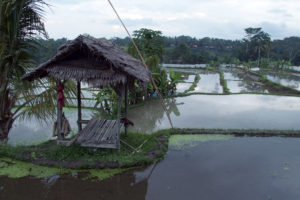
I’ll admit, Ubud isn’t perfect. For such a small town, the traffic congestion is pretty annoying and it can be somewhat difficult to find traditional Balinese food in the center of town. Still we were somehow able to find a tranquil little hideaway without having to walk too far and it was pretty easy to get out of the chaos and into a peaceful tropical paradise. The locals we met, aside from the pushy street vendors, were gentle, warm-hearted people who beamed with happiness. We liked it so much that we decided to focus our 30 day Indonesian visa on Bali alone. There are many other places that I’d like to go to in Indonesia but it would take quite a bit of time to visit more than one or two islands in a trip. This gave us the opportunity to relax and enjoy some gorgeous out-of-the-way places.
jim@snorkelbandits.com

